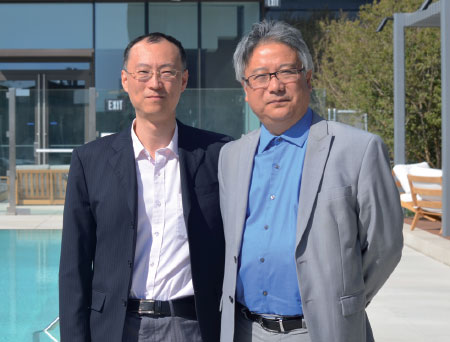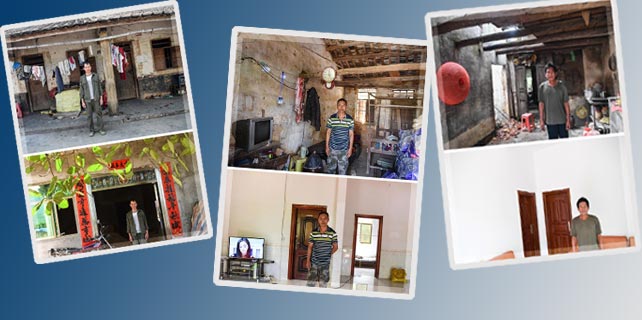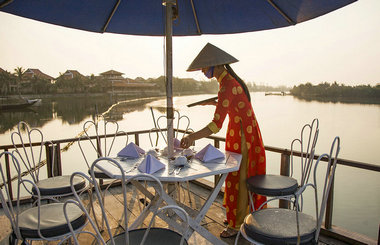Downtown LA comes alive
Downtown Los Angeles is undergoing its largest construction boom in modern times, and foreign investment, especially from Chinese developers, is adding thousands of residences and construction jobs, as well as restaurants, retail stores and entertainment venues, reports Lia Zhu from Los Angeles.
It can be seen in the numbers: At least 20 skyscrapers are being built; more than 5,000 condos are under construction; and 46,000 new jobs are expected from 2015 to 2020 in the hospitality and tourism industry.
Downtown Los Angeles is undergoing a rejuvenation, and Chinese property developers are playing a major role.
Not only is the new construction reshaping the city's skyline, it's also redefining the urban living style by creating a vibrant new shopping, dining and entertainment destination. The foot traffic in downtown Los Angeles is steady, young adults and families are opting for an urban lifestyle and new restaurants, stores and entertainment venues are taking advantage of the scene.
Five years ago, downtown Los Angeles was a place you didn't want to go at night, said Robert, an Uber driver who gave only his first name. "It was empty at night and weekends. People didn't really live down here."
Robert said he used to avoid driving through the downtown area at night, but now he has many passengers going to downtown restaurants and night clubs. "It has totally changed face,"he said.
K. Allen Anderson, senior vice-president and general counsel of Greenland USA, said, "Los Angeles downtown wasn't at all the kind of downtown you see in other international cities, or even other major cities in the US.''
Exodus to suburbs
"For various reasons, cultural and land restriction reasons, for many years, buildings could not be taller than the city hall, which is about 20-storyies high,"he said. "So you never had the inner city growth. People grew out into the suburbs."
That started to change 15 years ago when the Staples Center and Ritz Carlton and JW Marriot hotels came to Los Angeles, and "that's been really accelerated by Chinese developers,"said Anderson.
Now those developers, such as Greenland, Oceanwide, Shenzhen Hazens and Lifan, are pumping billions of dollars into the city, adding thousands of new residential units in high-rise towers.
Stephen Cheung, president of World Trade Center Los Angeles, said Los Angeles is going through a renaissance that "we haven't seen in decades". "Looking at the population and the industry growing, you start seeing a new vibe that we haven't experienced before,"he added.
In the last 15 years, investment in downtown has exceeded $15 billion, and the weekday population has expanded to more than 500,000. More than 700 new restaurants, bars, retail and nightlife venues opened from 2008 to 2014, according to the Downtown Center Business Improvement District.
Chinese investments start
Greenland started the wave of Chinese investment with a $150-million acquisition of 6.33-acres of land -a parking lot-in South Park in late 2013. Now that site is "Metropolis", a high-rise tower complex.
With investment exceeding $1 billion, the four-building complex includes-an 18-story, 350-room hotel that opened on March 31, a 38-story residential tower with 308 condos that opened last month, and a 40-story tower with 514 condos and another 56-story tower with 685 condos under construction. The two buildings are slated to open in 2018 and 2019 respectively.
"I think Greenland USA's Metropolis is taking a leading role in the development in the downtown area,"said Hu Gang, president and CEO of Greenland USA, a subsidiary of the Chinese real estate giant Greenland Group. "Now we are taking the leadership of the market, also, and we are creating the market as well."
Oceanwide Plaza, another high-rise complex, and Shenzhen Hazens' proposed $700 million mixed-use project, along with the Metropolis, are reported to be the largest projects under construction in downtown Los Angeles.
Only several minutes' walk from the Metropolis is Oceanwide Plaza, another $1 billion mixed-use project by China Oceanwide, a privately owned investment company.
A 50-story Park Hyatt hotel with 184 rooms, and two 40-story towers with 504 condos is being built on the nearly 4.6 acres. Upon completion in early 2019, the project will feature a 700-foot ribbon-shaped LED signage, which is expected to be the largest LED screen on the West Coast.
When Thomas Feng, CEO and president of Oceanwide Plaza, arrived in Los Angeles in 2013, it was not a "hot destination"in most people's eyes. "Not many people were aware of the renaissance at that time,"he said.
The renaissance also was a result of the change in industrial and family structure, Feng said. "After manufacturing started fading in the 1990s, the lifestyle of big families living in a big house had changed, and the younger generation became the majority in the workforce, especially on the West and East coasts,"he said.
According to a 2015 report by Beacon Economics for the Central City Association of Los Angeles (CCALA) and the Downtown Center Business Improvement District (DCBID) of Los Angeles, the demand for apartments in downtown Los Angeles tripled from 2000 to 2013.
Now there are 5,636 condos, and more than 5,000 are under construction, most of them invested in by Chinese.
Who is buying the condos?
"New residents help drive the downtown renaissance, and we are clear about the demand, which is mixed-use buildings,"said Feng.
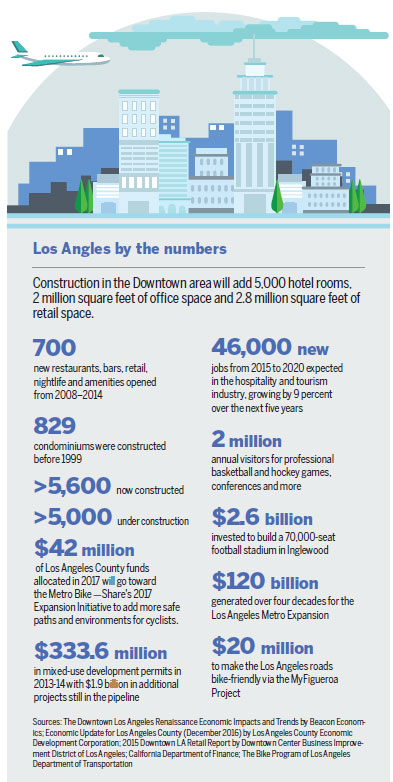
He also said that more young people, especially the millennium generation, want to live in downtown Los Angeles to avoid commuting and have more time for entertainment and being on the internet.
Residential Tower I of the Metropolis has been 80 percent sold and the price of the condos range from $600,000 to more than $2 million, according to Wu Chao, Los Angeles general manager of Greenland USA. He expects even higher prices for the other two towers that target a more upscale market.
Los Angeles has been a tight housing market for a long time. Over the last 20-30 years, there hasn't been enough building of housing units to support the growth in population and demand, which is why housing prices increased over the last decade, said Cheung.
The recession in 2008 also played a role. There was a lot of development to the east and north of Los Angeles then, but "a lot of the market crashed"when the recession occurred, said Anderson. "In the last 10 years, it really changed. I think people started coming because of the value they saw created by the recession,"he said.
Chinese investors started coming to Los Angeles after the financial crisis, around 2010, said Andrew Pan, senior vice-president and head of Chinese business and strategy at East West Bank.
"When China's real estate market cooled down, major Chinese developers had to find a market to keep their capacities going, and the US developers were still recovering from the crisis,"said Pan, who has worked in downtown Los Angeles for more than 10 years and watched the changes.
First Stop
Los Angeles was the Chinese investors' first stop because it's a gateway city, and the downtown is the closest metropolitan area to China, he said, adding that the area was attractive for developers because of relatively low construction costs and more reasonable property prices.
In Manhattan, a condo can cost more than$1,500 per square foot and in San Francisco more than $12,000 per square foot, but in Los Angeles the average condo cost is $700 per square foot.
The Los Angeles city government has been aggressively attracting foreign direct investment, especially in the real estate industry for its downtown renaissance plan.
"I traveled with Los Angeles Mayor Eric Garcetti to China on a trade mission years ago. The mayor said the skyline of all the Chinese cities visited-Beijing, Shanghai, Hong Kong-were so beautiful. The lights and contemporary designs were unbelievable. He said, 'I want to change the Los Angeles skyline,'"recalled Pan.
Then the government promoted real estate development, and came up with the innovative "parallel permit process", allowing developers to start construction before going through the entire process, which usually takes two to three years.
"Now it takes only a year or a year and a half. By saving a lot of time, you can control the cost,"said Pan.
A proposal for a 28-story mixed-use tower by Lifan Group, a major Chinese manufacturer of automobiles and motorcycles, was filed early this year, and the company expects to finish permit procedures by the end of this year. By April, the demolition work on the 1-acre site had been completed.
"There's been a challenge for Chinese developers to navigate US rules and regulations, but it's been an education,"said William Wang, vice-president of Lifan USA Real Estate, Inc, a subsidiary of Lifan Group.
The Lifan Tower will have 305 residential units and 15 percent will be low-income residences. "We were not familiar with that (low-income residence). After talks with the city, we decided to contribute to the supply of low-income housing because by giving back to the community, you can earn something else."
Wang said that his company hires local professionals - from legal, financial to public relations - to make sure it follows and respects local laws and the culture.
A couple of other Chinese developers' projects in downtown Los Angeles are undergoing the permit process, including Hazens's proposed three towers with a 300-room W Hotel and two mixed-use buildings with 650 condos and approximately 80,000 square feet of retail space.
Since 2014 to 2016, Chinese developers were involved in at least seven of 18 land deals in the downtown area that were valued in excess of $19 million, according to the Los Angeles Times. They have been involved because of their strong background in building residential towers in China, said Cheung.
"Not only do they bring the capital, they also bring the know-how, and the ability to construct quickly and in a cost-effective manner,"he said. "These major billion-dollar construction projects are happening over and over again, and it's all done by Chinese investors."
Winston Yan, CTO and vice-president of Greenland USA in Los Angeles, is proud of the speed at which the Metropolis is being built, considering the complex and tough seismic building codes.
Compared with the magnitude of Greenland's projects in China, the Metropolis isn't one of the largest, but it will have deeper and more far-reaching impact on Los Angeles and Angelenos than economic value, said Yan.
"As people live farther and farther, driving longer distance, they also cause many urban problems such as traffic congestion and pollution. We want to introduce this environmental lifestyle, which is actually an old style only long forgotten,"he said.
Contact the writer at liazhu@chinadailyusa.com
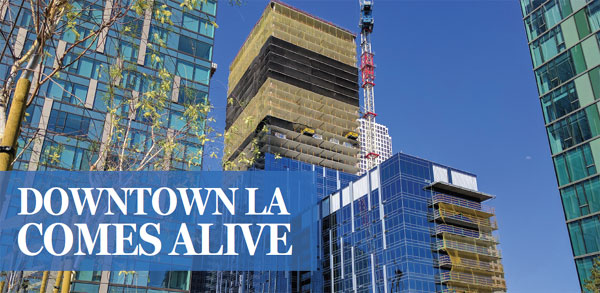
|
Wu Chao (left), Los Angeles general manager of Greenland USA and Winston Yan, CTO of Greenland USA in Los Angeles at the amenity level of Tower I of Metropolis, with Tower III and Tower IV in the background. The residential tower has been open to residents since last month. Lia Zhu / China Daily |
(China Daily USA 05/19/2017 page20)



